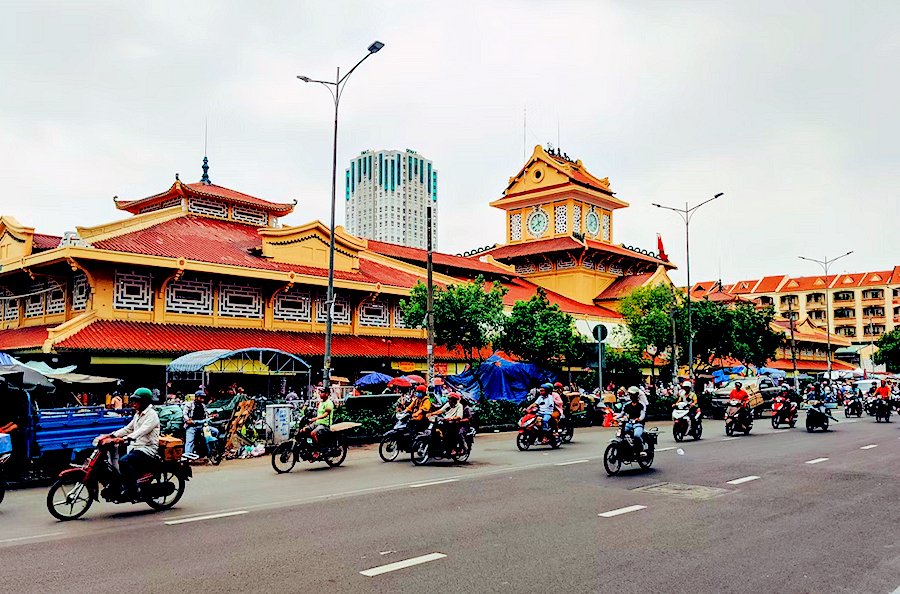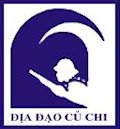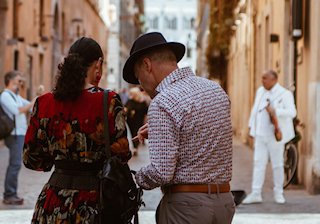Travel Notes: Destinations: Asia: Vietnam - Ho Chi Minh City Travel Guide.
Short URL: https://tnot.es/SGN
Travel Guide For Visitors to Ho Chi Minh City
Explore the best attractions, street food markets, and cultural experiences in Ho Chi Minh City with insider tips and practical advice to discover former Saigon. Share on Facebook
Bringing Together Old and New
Ho Chi Minh City is bustling metropolis in the south of Vietnam, offering a mix of modern skyscrapers, historic landmarks, and vibrant street life.
 Add a Business -
Add a Location -
Add a Lodging - Add Travel Content
- Add URL
- Travel Services.
Add a Business -
Add a Location -
Add a Lodging - Add Travel Content
- Add URL
- Travel Services.
High Energy Ho Chi Minh City
Ho Chi Minh City pulses with an intensity that's both overwhelming and utterly captivating.
This sprawling metropolis of over nine million souls has shed its wartime shadows to emerge as South-east Asia's most dynamic urban playground.
The city has recently evolved into a hotspot for digital nomads thanks to its cheap cost of living, whilst offering wonderful shops, fantastic nightlife, delicious food, and plenty of historic sites.
Whether you're drawn by the layers of history, the legendary food scene, or the sheer vibrancy of Vietnamese urban life, Ho Chi Minh City delivers experiences that linger long after you've left.
Planning Your Visit to Ho Chi Minh City
Best Time to Visit Ho Chi Minh City
Ho Chi Minh City's tropical climate means warm weather year-round, but timing matters.
The Dry Season (December to April) offers the most comfortable conditions with lower humidity and minimal rainfall.
Temperatures hover around 26°C to 30°C, perfect for wandering the streets and exploring outdoor markets.
The Wet Season (May to November) brings afternoon downpours and higher humidity, though mornings often remain clear.
Don't let the rain deter you; it's typically short-lived and the city takes on a different character when the streets glisten.
Getting Around Ho Chi Minh City
Districts Explained
District 1 is where all the action is, with the hippest restaurants and bars, plus must-see attractions like the Reunification Palace, Notre Dame Cathedral, and Ben Thanh market.
Most first-time visitors spend their time here, and for good reason; it's compact, walkable, and packed with colonial architecture.
Transport Options
Grab - The ride-hailing app is your best friend here.
Motorbike taxis are cheap and thrilling, whilst cars offer air-conditioned comfort.
Motorbike Rental is only really for the adventurous, as traffic can be intimidating for newcomers.
Walking - District 1 is surprisingly walkable once you master the art of crossing busy streets; walk slowly and predictably.
Top Attractions in Ho Chi Minh City
Architectural Highlights
Central Post Office
Designed by Gustave Eiffel, this stunning example of colonial architecture features soaring ceilings, intricate ironwork, and a portrait of Ho Chi Minh watching over the postal workers.
Notre Dame Cathedral
Built by French colonists in the 1880s, this neo-Romanesque cathedral anchors the heart of District 1.
The red brick exterior and twin spires create a striking contrast against the modern cityscape.
Opera House
Buildings like the Hotel Continental Saigon, the Hotel Majestic Saigon, Ben Thanh Market, and the Ho Chi Minh City Museum of Fine Arts are scattered throughout the city.
The Opera House exemplifies French colonial elegance with its ornate façade and grand interior.
Historical Sites and Museums
Cu Chi Tunnels
One of the best things to do in Ho Chi Minh City is make a day trip out to the Cu Chi Tunnels.
Located 60km north-west of the city, this underground network demonstrates the ingenuity and determination of Vietnamese fighters.
The tunnels are part of a war museum, where you can learn more about the Vietnam War and crawl through the cramped underground spaces to get a sense of how the Viet Cong fought their battles during the war.
Reunification Palace (Independence Palace)
This 1960s time capsule served as South Vietnam's presidential palace until tanks crashed through its gates in 1975, ending the war.
The preserved rooms, including the eerie basement war room, offer fascinating glimpses into this pivotal moment.
War Remnants Museum
The War Remnants Museum presents Vietnam's perspective on the American War (as it's known locally).
It's emotionally heavy but essential for understanding the country's recent history.
Where to Stay in Ho Chi Minh City
District 1 remains the top choice for first-time visitors to Ho Chi Minh City.
You'll find everything from backpacker hostels around Pham Ngu Lao Street to luxury hotels near the Opera House.
The area buzzes with energy and puts major attractions within walking distance.
District 3 offers a more local feel with excellent restaurants and cafes, whilst remaining close to the action.
It's perfect if you want to experience neighbourhood life without sacrificing convenience.
Tourist Map of Ho Chi Minh City
Use the Tourist Map of Ho Chi Minh City to help you decide where to stay in Ho Chi Minh City based on travel budget, preferred location, planned must-see attractions and local must-do activities.
Ho Chi Minh City Food Scene
Best Food Markets and Streets
Ben Nghe Street Food Market
This large street food, food court should be on every tourists to do list whilst in Ho Chi Minh City.
Though more touristy than traditional street food, it offers a safe introduction to Vietnamese cuisine with varied options under one roof.
Find it in District 1, across the street from the entrance to the Independence Palace.
Ben Thanh Market
This iconic market buzzes with activity from dawn to dusk.
The daytime market offers produce, spices, and souvenirs; whilst the evening food stalls serve excellent Vietnamese dishes.
Ho Thi Ky Food Street
Ho Thi Ky Food Street offers a variety of light dishes perfect for those seeking refreshing fare.
The selection includes green papaya salad, fresh spring rolls, and mixed rice paper (banh trang tron); a traditional food in Ho Chi Minh City.
This lesser-known gem near the flower market serves authentic local dishes without the tourist markup.
Street Food Culture
The real magic of Ho Chi Minh City happens at street level, where tiny plastic stools and steaming bowls create the city's most memorable dining experiences.
Vietnamese street food culture thrives here, with vendors specialising in single dishes perfected over generations.
Banh Mi (Vietnamese Sandwich)
French baguettes meet Vietnamese flavours in this beloved sandwich.
Crispy bread cradles pâté, pickled vegetables, herbs, and your choice of protein.
Street vendors sell them for breakfast, lunch, or whenever hunger strikes.
Banh Xeo (Sizzling Crepes)
These turmeric-tinted crepes arrive sizzling at your table, filled with shrimp, pork, and bean sprouts.
Wrap pieces in lettuce with herbs and dip in nuoc cham sauce for the full experience.
Pho (Vietnamese Noodle Soup)
While Northern Vietnam claims pho's origins, Ho Chi Minh City has perfected its own version.
The southern style features sweeter broth, more herbs, and wider noodles.
Try it at dawn when vendors serve the freshest bowls.
Cultural Experiences
Understanding Vietnamese Culture
Ho Chi Minh City represents modern Vietnam's complexity; a place where ancient traditions adapt to rapid modernisation.
The city's youth embrace global trends whilst maintaining deep respect for family and cultural values.
Local Customs
Remove shoes before entering temples and homes.
Dress modestly when visiting religious sites.
Bargaining is expected at markets but approach it as friendly negotiation rather than confrontation.
Temple Visits
Jade Emperor Pagoda stands as the city's most atmospheric temple, thick with incense smoke and devoted worshippers.
Cao Dai Temple offers insights into Vietnam's unique indigenous religion.
Shopping in Ho Chi Minh City
Modern Shopping
Dong Khoi Street
This pedestrian-friendly street in District 1 features boutiques, galleries, and cafes housed in beautifully restored colonial buildings.
It's perfect for afternoon strolls and window shopping.
Nguyen Hue Walking Street
The city's modern pedestrian boulevard comes alive in the evenings with street performers, families, and young couples.
The LED flower displays create Instagram-worthy backdrops.
Traditional Markets
Binh Tay Market
Located in Cholon (Chinatown), this wholesale market offers authentic local shopping away from tourist crowds.
The art deco architecture alone makes it worth visiting.
Tan Dinh Market
Although fabrics and food are Tan Dinh market's specialties, the market contains a lot more commodities; clothing, footwear, fresh produce, household items, and accessories.
This local market provides genuine Vietnamese shopping experiences.
Nightlife and Entertainment
Rooftop Bars and Clubs
Ho Chi Minh City's nightlife scene rivals any major Asian city.
Rooftop bars offer stunning skyline views, whilst ground-level venues pulse with live music and dancing.
Nguyen Hue Area
The walking street transforms after dark into an outdoor party venue.
Families enjoy early evening strolls whilst young locals gather for drinks and socialising.
Pham Ngu Lao Street
The backpacker district maintains its reputation for budget-friendly bars and international crowds.
It's loud, chaotic, and undeniably fun.
Day Trips from Ho Chi Minh City
Mekong Delta
The Mekong Delta's intricate waterways, floating markets, and rural villages offer peaceful contrast to urban intensity.
Day trips typically include boat rides, traditional craft workshops, and authentic rural Vietnamese meals.
Tay Ninh Province
Beyond the Cu Chi Tunnels, Tay Ninh Province offers Cao Dai temple visits and Black Virgin Mountain climbing.
The combination of spiritual sites and natural beauty makes for rewarding day trips.
Practical Information
Language
English is increasingly spoken, especially in tourist areas and among young people
Learning basic Vietnamese phrases shows respect and often earns smiles from locals.
Money and Costs
Vietnamese dong (VND) is the local currency, though US dollars are widely accepted.
ATMs are abundant, and most restaurants accept cards.
Street food costs 20,000-50,000 VND per dish, whilst restaurant meals range from 100,000-300,000 VND.
Safety Tips
Ho Chi Minh City is generally safe for tourists, though petty theft occurs.
Traffic appears chaotic but follows its own logic; cross streets slowly and confidently.
Keep valuables secure, especially when riding motorbikes.
Ho Chi Minh City is Rewarding - If You Give it Time
Ho Chi Minh City attracts a large number of tourists each year thanks to its prominent features in terms of history, culture, architecture, cuisine and people.
Yes, it's hot, humid, and hectic; but it's also historically significant, culturally rich, and undeniably alive.
Give yourself time to adjust to the city's rhythm.
Sit on those tiny plastic stools, navigate the controlled chaos of street crossings, and engage with the remarkably welcoming locals.
Ho Chi Minh City doesn't seduce visitors with obvious charms; it wins them over through authentic experiences and genuine human connections.
The city challenges preconceptions whilst delivering adventures that range from historically profound to deliciously simple.
Whether you're crawling through war tunnels, slurping pho at dawn, or watching the sunset from a rooftop bar, Ho Chi Minh City creates memories that feel both intensely personal and universally significant.
When Visiting Ho Chi Minh City
Plan for sensory overload, cultural revelations, and perhaps the best bowl of noodles you'll ever taste.
Ho Chi Minh City doesn't offer easy tourism; it offers transformative travel.
More City Travel Guides
City Guides: Cities in Africa - Cities in America - Cities in Asia - Cities in Australasia - Cities in Latin America - European Cities and Regions.
More From Travel Notes
Travel Notes Online Guide to Travel
Africa - Asia - Caribbean - Europe - Middle East - North America - Oceania - South America.
The Travel Notes Online Guide to Travel helps visitors plan their trip with country and city travel guides, local tourist information, reviewed web sites, and inspiring travel content.
Travel and Tourism Guides on Travel Notes
 If you find Travel Notes useful, please take a moment to
like us on Facebook and share with your friends on social media.
If you find Travel Notes useful, please take a moment to
like us on Facebook and share with your friends on social media.
Share on Facebook
Travel Resources
.
Travel & Tourism With Industry Professionals.















